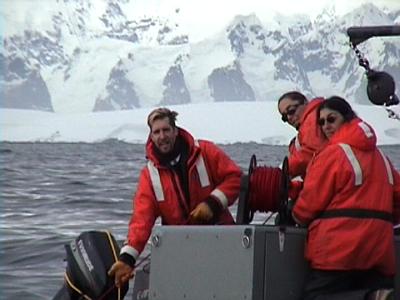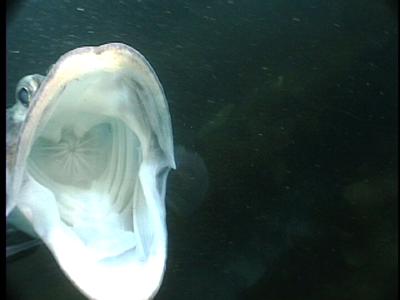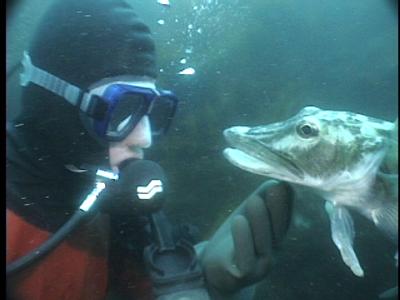6 December, 2000
Greetings,
Mr. Mcloed's class in Cheyenne Wyoming had a few questions. Jordan and
Brenna wanted to know the following:
1. What is it like in the ice caves?
It was amazing being in the ice cave. I enjoy exploring new places. The ice
is at least 10,000 years old and who knows what might be frozen in that
thick ice. The ice cave is a beautiful color blue. That has to do with the
way the light passes through the ice and snow. We had to drop down through
a six-foot hole to get into the cave. It was surprisingly warm on the
inside. Below freezing, but out of the wind. There were some icicles
hanging from the ceiling in several places. This is where the ice and snow
had melted and then froze again as the temperature dropped. I was told that
the cave has changed since last year. A portion of the cave has caved in so
it's about two-thirds its length from last year. It was a very interesting
journey.
2. Have any baby penguins hatched yet?
No baby penguins yet. I will post in my journal and let you know when the
first have arrived. I'm scheduled to go to Torgersen and Humble island on
Saturday. I hope to see some babies.
3. Are seals dominant?
Seals are the dominant predators. The Leopard seal preys on penguins,
krill, other seals and fish to mention a few. While the Crabeater seal and
Fur seal eat mainly krill, fish and squid. The Weddell seal and Elephant
seal eat mainly fish and squid. There is a predator of the seal, the Killer
Whale or Orca.
4. What is the Antarctic like?
It is hard for me to describe the entire continent since I have only been
in a small area. To be specific the Antarctic Peninsula. To get a better
view of the continent make sure you read Karina Leppik and Richard Smith
who are both at the South Pole. Also read to see who is at McMurdo. All
three locations are different and would be glad to answer your questions.
Palmer Station is located on Anvers Island in the peninsula of Antarctica.
We are located on the southwest corner of the island. There are several
large mountains in the area. Most are covered with snow and glaciers with
rocks peeking through here and there. Arthur Harbour, the harbor where
Palmer is located has a large glacier that calves into the water. We also
have icebergs drift in regularly. In fact there is a large one in the
harbor today. At high tide they come in and get stuck when the tide goes
out. I guess I could sum it up in a few words. This place is awesome.
5. Is it fun down here?
It is a lot of fun for me. Where else on the planet could you wake up in
the morning and see icebergs, glaciers, seals and penguins everyday. Not
only that but I am allowed to parcticipate in interesting science.
Also from the same class Bridgette and Margaret wanted to know the following.
6. What are krill used for?
Krill are the main food source for many of the animals that live here or
live here for just the summer months. Yesterday I was watching the Brown
Skua and the Antarctic Terns diving into the water to catch some krill.
There are also a few countries that fish for krill as a food source.
7. How big is the ship you guys are on?
We have two different zodiac boats. There is a small one that will hold 6
people and the larger boat will hold 10 people. Most of our larger zodiac
boats have instruments or other equipment attached inside so they seat
fewer people. When we go out to test on Mondays and Thursdays our boat is
full with three people and the equipment we use.
8. About how many animals do you see a day?
On station I see about 10 to 15 penguins. If I am going out in a zodiac I
see quite a few more. On Torgersen there are thousands of penguins and they
are always swimming by the zodic as they are going out to eat some krill.
When I'm on station I see about one seal a day, but if I get out in a
zodiac I will see 4 to 5 seals. As for Brown Skuas and Antarctic Terns
there are hundreds flying around station, to numerous to count. I have seen
whales a couple of times but they were a distance away from station.
Let me tell you what I have been up to the last couple of days. Yesterday
we took the zodiac out to station E to conduct a deep cast. The zodiac that
we were using is called Wonderbread. I'm not sure why, but it has a hand
cranked winch. Our electronics package weighs probably around 100 pounds.
Attached to it we have a safety rope and our winch line. We conducted three
casts at 100 meters and had to pull it up. Ray, Sarah and myself were a bit
sore last night. We are going out again tomorrow in Wonderbread to gather
more data.
Dan Martin and Wendy Kozlowski dive around station on occasion. Mainly
these are training dives. When they were out the other day they came across
an Ice Fish. The fish are very interesting because they have antifreeze for
blood. Antifreeze is a substance many people put into the car radiators to
prevent them from freezing during the winter. It works by lowering the
freezing point of the water that it is mixed with. The same is true of the
Ice Fish. That allows it to live in water that is colder than zero degrees
Celsius.
I am sending in a short movie of the Ice Fish. In the short movie you can
see the Ice Fish swim up to the diver, Dan Martin, and then open its mouth
and try to eat the camera. Its some great footage. Make sure you look for
it. Others are on the way. Don't miss tomorrows story about an interesting
arachnid. I didn't even know this type of arachnid existed in Antarctica,
but I will have a picture for you. Not for the squeamish, but it's really
cool.
C-ya tomorrow,
-- Bill

Kirk Ireson, Wendy Kozlowski and Sylvia Rodriguez pulling in the PRR. This is a great place to work!

Look mom, no cavities!

The Ice Fish swims up to Dan to say hello.
Contact the TEA in the field at
.
If you cannot connect through your browser, copy the
TEA's e-mail address in the "To:" line of
your favorite e-mail package.
|
